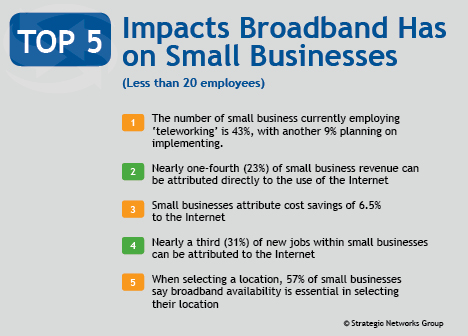
Goodbye Steve Jobs… Please Find Us some Innovators on the Way out the Door
What Jobs Taught Us About Driving Broadband Utilization
by Doug Adams
As a marketer, Steve Jobs has always been on my short list of ‘most admired.’ His ability to innovate and wrap his products in the flag of an Apple culture was (and is) remarkable. My wife, the traditional Apple zealot explained what his leaving meant… she said simply, that Apple will “never be the same” – that what’s missing is the ‘magic touch’ that made Jobs legendary.
What Jobs was able to do was tie technology to meaning… to, as Don Draper quips in the famous Mad Men scene… take technology from a “glittering lure” and, on rare occasion, “engage the public beyond flash, if they have a sentimental bond with the product.” For those interested in the clip, view it on You Tube.
Jobs drove e-Solutions with his vision, innovation, and design… but mostly by convincing consumers that to Think Different was special.
He used the Apple culture (or the cult of Apple depending on your view) to engage and drive e-solution adoption. By making his products easy-to-use, he went beyond mere adoption and achieved utilization. The type of deep, involved utilization that made upgrades a must have, not just a nice to have.
It was Jobs vision that the broadband would make the computer the ‘digital hub’ of the home that drove electronics and accompanying applications at a dizzying rate, transforming an industry and a world of users. Without broadband, it is at least possible that Apple does not exist today. Instead, it’s the most valuable consumer brand in the world.
So now Apple now has a void. But more significantly for our purpose is the question… how do we, as broadband evangelists… do what he did?
I tend to cringe when I hear broadband described as a ‘utility.’ While that might be an accurate description, would anyone trying to drive exciting, transformative e-solutions describe the road there as a ‘utility?’ Does our economy’s future depend on a ‘utility?’
The simple answer is yes – electricity is a utility, one for which we depend mightily. But its existance does not inspire. We need to engage and inspire in 2011 when driving broadband use because it is not ingrained in our society to the depths that ‘traditional’ utilities are.
What we need are solutions that transform our world, build on a platform for innovation. We need to be as vigorous in selling broadband’s benefits as Jobs would with the latest iSomething.
Broadband has the ability to radically change our entire world in orders of magnitude more than it already has. But we need to get past the utilitarian view of broadband – looking at what it enables and instead what it empowers. At the advent of broadband, Apple’s campaign challenged us to push the world forward. Is what we’re doing enough to drive the complete transformative power of broadband… or do we need to Think Different?
If you haven’t moved for a job, you know someone who has. More than a decade into our broadband revolution, the knowledge economy, and e-everything, it’s a bit discouraging to find that, even today, geography can still dictate individual or organizational potential for success. Still, in 2011, the digital divide limits job and opportunities, either at an organizational or an individual/entrepreneurial level, in rural areas.
SNG’s Research Featured in “10 Economic Development Facts” and 5 More SmallBiz Facts
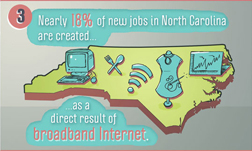
 The Internet Innovation Alliance (IIA) ( www.internetinnovation.org/) released its 10 ways broadband contributes to job creation and serves as a connector of job seekers, employers and employees. Sources for the research include the American Library Association, the Federal Communications Commission, and SNG.
The Internet Innovation Alliance (IIA) ( www.internetinnovation.org/) released its 10 ways broadband contributes to job creation and serves as a connector of job seekers, employers and employees. Sources for the research include the American Library Association, the Federal Communications Commission, and SNG.
Click here for the top 10 list.
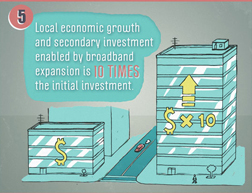 In the spirit of lists, we’ve come up with our own for this month’s issue of Bandwidth. Using SNG’s Digital Economy Analytics Platform (DEAP), containing data from regions across the U.S. and the globe, we present the…
In the spirit of lists, we’ve come up with our own for this month’s issue of Bandwidth. Using SNG’s Digital Economy Analytics Platform (DEAP), containing data from regions across the U.S. and the globe, we present the…
New Dimensions to the Digital Divide
by Derek Murphy & Michael Curri
The digital divide has long been commonly understood to mean unequal access to the Internet and its accompanying resources and services.
But as connectivity expands to more households, attention shifts to how people use and benefit from the Internet. Not surprisingly, another dimension to the digital divide emerges as not everyone is equally able to use and benefit from the Internet, even when they have and use the Internet. The same factors that impact adoption of the Internet have a pronounced impact on how effectively people are leveraging the Internet.
At SNG, utilization is a key metric we examine in all regions. In the past year, SNG collected utilization data in four states from over 12,534 organizations (commercial and non-commercial) and 4,638 households giving us unique insights into this new dimension to the digital divide. Some findings are not surprising while some provide new and unique insights that cause us to take a step back and wonder how we – as an industry – should define the digital divide moving forward.
The Big Picture:
Not surprisingly, SNG’s research shows that age and income have very significant impacts on how people use the Internet. Our proprietary Digital Economy index (DEi) summarizes how households use thirty distinct Internet activities. The higher the DEi, the more Internet activities a household engages. The Digital Economy index progression from 1 to 10 (10 being highest) reflects the number of e-solutions being utilized – 10 being a household at 100% utlization.
Utilization is impacted by income and age – the lower a household income or the older the household, the lower its Internet utilization. The differences (or divide) is most pronounced for those over 55 and those making less than $30,000. So the digital divide is actually expanding as younger, higher income households best leverage e-solutions.
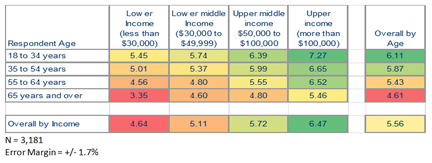 Click on chart for a larger version.
Click on chart for a larger version.
Without a ‘Next Step,’ It’s Just Numbers
SNG’s research (above) clearly shows:
- As we all know, computer and Internet skill levels affect broadband utilization, but more interestingly:
- The lower your income, the lower your utilization.
- The older you are, the lower your utilzation.
So lower income individuals ages 55-plus land at the lowest level of utilization. Conversely, younger and upper income households are at a higher level of utilization, leveraging broadband more effectively and deriving the most benefits – further increasing the digital divide.
Simply connecting… or even basic adoption does not complete the process of bringing people and households into the digital world. Even among those who are already using the Internet, there is a digital divide.
So we need to do better, including designing Internet outreach and training programs to the groups that are still experiencing the divide. How will the older generation be able to use Telehealth if they can barely accomplish basic Internet activities?
Digging deeper, for those interested in the details!
Where, specifically, are household struggling to adopt Internet activities? Our studies show that some skills and activities are easier to learn than others – the table below shows the activities where there is still a divide. E-mail, browsing and research are actively used by 80% or more of households. However, teleworking, selling online and using VOIP are significantly more challenging – but that’s where the biggest benefits from utilization are derived.
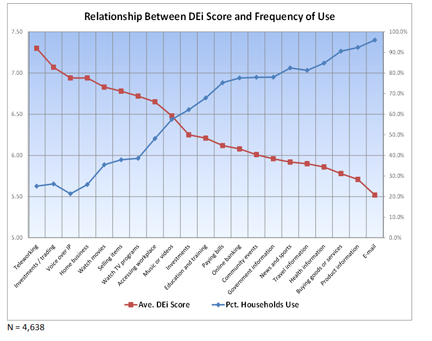 Click on chart for a larger version.
Click on chart for a larger version.
The earning ability of lower and middle income households is enhanced by the very Internet activities for which they’re least skilled. Economic development investments by government or nonprofits should focus on helping drive the utilization of e-solutions that generate the most benefits for inviduals. A starting point might be more focused, targeted training for those e-solutions that have the most significant, long-lasting socio-economic impacts.
by Michael Curri & Doug Adams
An SNG study of nearly 600 businesses in North Carolina has revealed a direct correlation between revenue growth and the adoption and use of e-solutions.
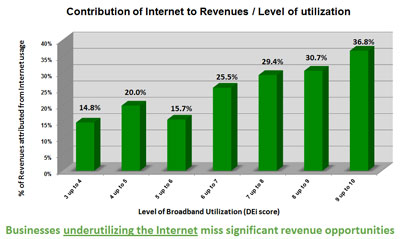 According to the research, higher levels of utilization generate higher revenues and greater benefits for businesses. The most significant impacts on a firm’s bottom line are more sophisticated e-solutions such as teleworking, selling goods or services online, etc. – which means that firms that are not ‘fully online’ are missing out on significant potential revenue. In some cases they could grow by more than 30%.
According to the research, higher levels of utilization generate higher revenues and greater benefits for businesses. The most significant impacts on a firm’s bottom line are more sophisticated e-solutions such as teleworking, selling goods or services online, etc. – which means that firms that are not ‘fully online’ are missing out on significant potential revenue. In some cases they could grow by more than 30%.
By measuring over 17 activities classified as “e-solutions,” or Internet enabled applications, SNG has developed a Digital Economy index (DEi) which measures the utilization of broadband as a platform for innovation. DEi scores range from 1 to 10 (10 being highest), with higher scores reflecting the greater the number, scope and sophistication of the Internet activities deployed in an organization.
The data indicate that businesses with a high DEi, meaning higher levels of adopting and using e-solutions, experience larger percentage increases of revenues (between 27 and 31%).
SNG’s research thus demonstrates that increasing Internet utilization dramatically increases corporate revenues and job creation.
The Impact of Broadband on Jobs
The North Carolina study reveals that the Internet contributes significantly to job growth, especially among organizations with less than 50 employees who represent over 94% of all firms and 44% of all employment.
The table below shows a complex dynamic where large numbers of jobs in over 1,000 organizations were created and lost over a 12 month period in 2009/2010. As in any economy where there is job creation and job loss, the most important challenge is to drive net positive job growth. North Carolina is seeing job loss (as shown in “% Net Jobs Created”). The key is how many sustainable, knowledge sector jobs they can create through innovation.
As the column “% Net Jobs Created thru Internet” indicates, small, nimble firms (less than 50 employees) are leveraging the Internet and e-solutions and creating new jobs at a rate of more than 8% of their existing base, which is a significant difference from the over 14% decline in job losses overall.
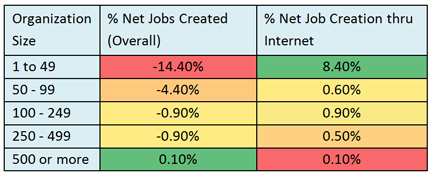 This picture of both job creation and loss is a more realistic insight into the process of economic change and development within North Carolina. One key finding from this table is that jobs associated with use of the Internet grew across all organizational sizes, even while major job losses were being experienced. This is particularly significant in organizations with 1 to 49 employees.
This picture of both job creation and loss is a more realistic insight into the process of economic change and development within North Carolina. One key finding from this table is that jobs associated with use of the Internet grew across all organizational sizes, even while major job losses were being experienced. This is particularly significant in organizations with 1 to 49 employees.
As a part of each SNG study, we take a close look not only at adoption rates and driving utilization – but also at preferred learning methods to bridge their skills gaps. It’s about individual users understanding which e-solutions will give them the biggest benefits and having the capacity to use those applications.
When individuals and households need to acquire knowledge, they turn to the resources they have at hand – and of course, the learning methods they prefer. It’s about moving businesses, organizations and households up the learning curve more effectively so that they realize the benefits from broadband and e-solutions as quickly and fully as possible.
Not surprisingly to our marketing department, among households “word of mouth” still scores high as a means for learning. But traditional methods are clearly taking a back seat to online learning – both informal (general surfing) and formal (webinars and online courses). Books, workshops, and classes all come after online methods (and word of mouth) as preferred learning methods. So it is clear that we have a bit of ‘chicken and the egg’ situation here as the question becomes – how does someone maximize their learning potential, without having online resources? The digital divide obviously goes hand-in-hand with a knowledge gap.
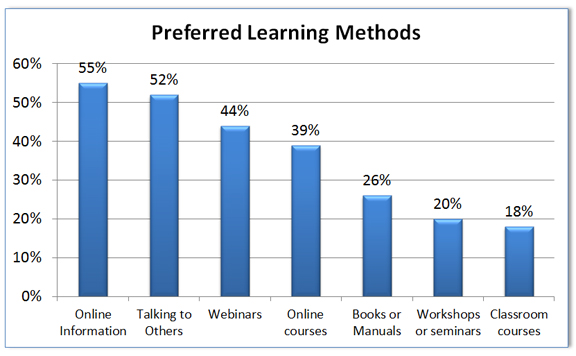
The same study revealed that 2 in 3 organizations plan to acquire at least two distinct skills sets over the next year – some through hiring, and some through training.
Here again we see a preference for online learning methods as self-directed methods of knowledge development, including online research and webinars, are the most likely to be used by the majority of organizations. In-person classroom training is the least likely method to be used.
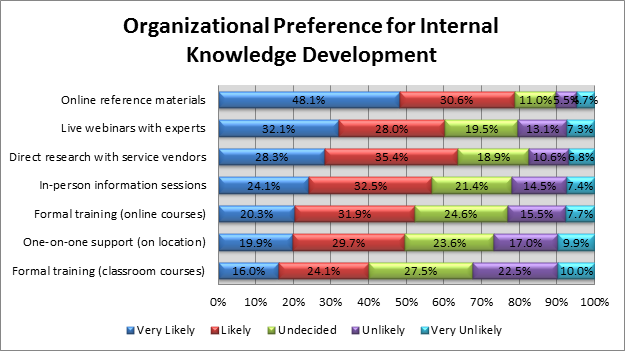
So, when planning for broadband, also plan for learning. Not only is it important to understand where the awareness and skills gaps are, but also understanding the preferred modes of learning. An effective strategy for economic development through broadband requires this.

Rollie Cole
Contributed by Roland J. Cole, Ph.D., J.D.
Residential broadband (distinguished from commercial broadband) is critical for bottom-up economic development. With this, there are a number of regions in the US (and in other countries) where big entities – private firms as well as government agencies, universities, and hospitals have access to broadband that is high speed and affordable, but the residences in that same community do not. In the US, while federal funds are being allocated to extend broadband to “community anchor institutions,” including hospitals, there is little or nothing being done to extend it to the residences around those institutions. I’ve seen one hospital program myself that refuses to share access with the offices of doctors that serve in the hospital, let alone the homes where they live. I’ve learned of a city that has, to great acclaim, extended its fiber to large firms, but feels that residences and small firms do not need anything better than the cable and telephone companies are currently providing.
As SNG has reported (most recently in the June Issue of Bandwidth that prompted me to write this piece), a lot of purely “economic” activity takes place in homes or in sites small enough that broadband network operators treat them as homes. In North Carolina, 1/3 of those with broadband already had a home-based business, and more than 1/10 were planning to start one within the year. These activities are in addition to employees of large firms that work from home. They are also above and beyond those using the Internet to seek employment opportunities, apply online, improve their skills, etc.
We’ve all heard stories of firms – countless numbers of them – that grew from basements, spare bedrooms, and garages. HP started in a garage; Dell started in a university dorm room. Some large firms that now include access to high-speed affordable broadband for their buildings as a top five or top ten item are now including access for their employees’ homes as a part of that item.
Residential broadband is important even for the firms that are out of the home, because small non-residential sites get offered the same bandwidth deals that homeowners get offered, albeit usually at twice or three times the price. The network providers (both public and private) do special deals for large end-users, but NOT for small ones.
Better bandwidth for these purposes is not just “speed” and price, because “speed” usually refers to download speed – largely a measure of consumption, not production. These individuals and small firms are producing, as well as consuming, and can use upload speed as well as download.
Video files are huge, CAD files are enormous, high-resolution photo files are large, database files have never been dainty… and you’re hard pressed to find organizations that do not include designers, marketers, architects, and engineers who need to transport these files. Of course you could deliver thumb drives with such files… but I also could send a letter as opposed to an email. I need to remain competitive, agile, and flexible to succeed in 2011. Lack of better broadband may not prevent home-based and small firm economic activity, but it sure discourages it. Better broadband provides the platform… the foundation to foster activities that grow businesses, and with them, our economies.
So for one measure of how “fertile” the ground is for bottom-up economic development activity in your community, track the price and upload speed offered to your residences. Do not be satisfied when your big companies and your “community anchor institutions” have reasonable broadband while residences do not. A big aid to the firms of the future, both large and small, is better residential bandwidth now.
Roland J. Cole is a lawyer and policy analyst (PhD/JD Harvard) who has been studying small business and economic development for over 30 years. His work has included three textbook chapters on the role of residential broadband and the development of a toolkit for community action in support of broadband improvement. He is currently a freelance policy analyst in Austin Texas, launching a new organization entitled Fertile Ground for Startups and Small Firms.
by Joan Engebrets
September 14th, 2011
The Digital Divide increasingly is based on age and income, rather than broadband availability, according to new research from Strategic Networks Group.
 The research firm has developed what it calls a “Digital Economy Index” to summarize how households use 30 distinct Internet activities. The company uses the index to rank households on a scale of 1 to 10, with 10 representing households that engage in 100% of activities.
The research firm has developed what it calls a “Digital Economy Index” to summarize how households use 30 distinct Internet activities. The company uses the index to rank households on a scale of 1 to 10, with 10 representing households that engage in 100% of activities. 
Using this methodology, SNG found that Internet utilization is lowest among households with incomes below $30,000 and in which household members are over 55.

